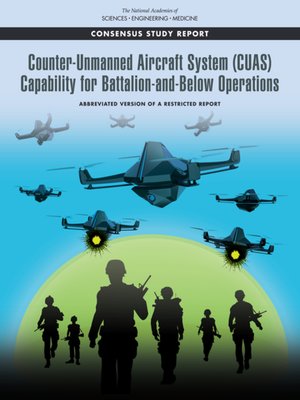Counter-Unmanned Aircraft System (CUAS) Capability for Battalion-and-Below Operations
ebook ∣ Abbreviated Version of a Restricted Report
By National Academies of Sciences, Engineering, and Medicine

Sign up to save your library
With an OverDrive account, you can save your favorite libraries for at-a-glance information about availability. Find out more about OverDrive accounts.
Find this title in Libby, the library reading app by OverDrive.



Search for a digital library with this title
Title found at these libraries:
| Library Name | Distance |
|---|---|
| Loading... |
The development of inexpensive small unmanned aircraft system (sUAS) technologies and the growing desire of hobbyists to have more and more capability have created a sustained sUAS industry, however these capabilities are directly enabling the ability of adversaries to threaten U.S. interests. In response to these threats, the U.S. Army and other Department of Defense (DoD) organizations have invested significantly in counter-sUAS technologies, often focusing on detecting radio frequency transmissions by sUASs and/or their operators, and jamming the radio frequency command and control links and Global Positioning System signals of individual sUASs. However, today's consumer and customized sUASs can increasingly operate without radio frequency command and control links by using automated target recognition and tracking, obstacle avoidance, and other software-enabled capabilities.
The U.S. Army tasked the National Academies of Sciences, Engineering, and Medicine to conduct a study to address the above concerns. In particular, the committee was asked to assess the sUAS threat, particularly when massed and collaborating; assess current capabilities of battalion-and- below infantry units to counter sUASs; identify counter-sUAS technologies appropriate for near- term, mid-term, and far-term science and technology investment; consider human factors and logistics; and determine if the Department of Homeland Security could benefit from DoD efforts. This abbreviated report provides background information on the full report and the committee that prepared it.







